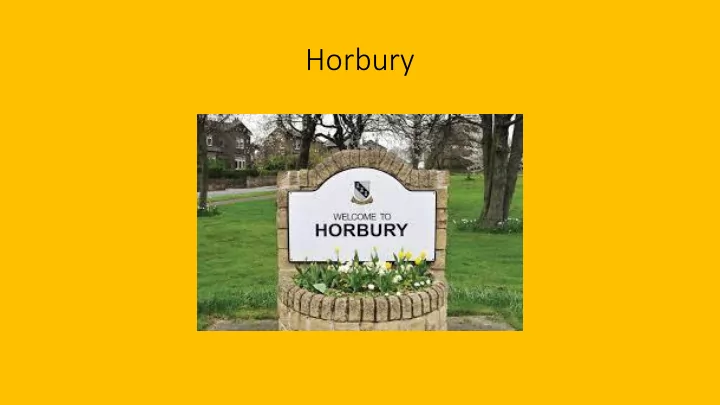

Horbury
Tithe Barn Street
Tithe Barn Street in Horbury was so named after the old tithe barn, which was used to store produce of the tithe. A tithe means a tenth and one tenth of every Horbury parishioner's income from produce of the land had to be donated to the church. The right to receive tithes was granted to the English churches by King Ethelwulf in 855. These tithes were taxes, which each inhabitant was compelled to pay. Horbury was a Chapel of Ease to Wakefield Parish Church, and the Vicar of Horbury was a Curate in Charge. The tithes which were collected from Horbury residents belonged to the Vicar of Wakefield and not to the Vicar of St. Peter's, Horbury. Above: The top of Tithe Barn Street where it meets Church Street showing St. Peter and St. Leonard's Church. Records still exist and the Horbury Tithe Account records the tithes that were paid by Horbury residents. The early tithe system had three distinct types: • Predial Tithes, where payments was made in crops • Mixed Tithes, where payment was in livestock • Personal Tithes, where a person paid his tithe by working These were further divided into Greater Tithes, which included payments in crops like oats, barley, wheat and also wool, then “Lesser or Smaller Tithes” that included every other category of payment. In Horbury, the Greater Tithes were payable to the Rector and the Lesser Tithes to the Vicar of Wakefield. Originally, tithe payments took the form of things like the tenth sheaf of wheat or barley, the tenth lamb or piglet, a tenth of hay or straw produced, etc. Thus the Tithe Barn was needed for storage. The tithe was a very unpopular tax and the system gradually ended with the introduction of the Tithe Commutation Act 1836, so that the tithe could be paid as a rent charge. Tithes were abolished altogether with the introduction of the Tithe Acts of 1936 and 1951 in the British Parliament.
The Old Town School
The Old Town School The first school to be founded in Horbury was the Town School on Tithe Barn Street, which dates back to 1708. A report dated 1827 shows "10 poor children" being taught and that the master’s salary was 15 guineas per year with a school house and garden plus the master's use of a further acre of land. An extension to the school and the schoolmaster's house was added in 1832. By 1870 there were 54 boys and 59 girls on school roll between the ages of 4 and 11 years, each paying between threepence and sixpence per week for their education (sixpence is the equivalent to £1.57 in today's currency). The school was closed in 1886. The building continued to be used by the Sunday School, which was founded in 1786 .
This small building is Horbury's old lock-up or "Kidcote" which dates back to 1710. It is a two-storey building, the ground floor formerly being used as a prison with only a small stone basin for comfort.
Carr Lodge Mansion
Possibly Horbury's finest house, the Grade II listed Carr Lodge Mansion has lain unused for many years now, slowly decaying as Wakefield Metropolitan District Council (WMDC), the current owners decide on the best use for the historic old building. This Grade II listed building was built between 1770 and 1775 for John Bayldon and was called originally Sunroyd House or possibly Little Thornes House, because the design is similar to Thornes House in Wakefield. In 1790, the house was conveyed to John Carr, lawyer, the nephew of John Carr the architect, who was born in Horbury in 1723. Carr bought Sunroyd House in 1789 and renamed it "Carr Lodge". The mansion was originally a private house within landscaped gardens including a historic walled garden. John Carr leased the house to tenants. John Carr died in 1824 and the property passed to his son, John Francis Carr. John Francis Carr made the mansion his family home with his three daughters Harriet, Mary Ann and Maria Hannah. In 1888, the mansion fell into the hands of the Parker family, who, it is believed, fell on hard times. After the death of Mrs. Parker, Carr Lodge was rented out to various tenants but at various times, Carr Lodge was untenanted for several years. Horbury Urban District Council (HUDC) bought the property and its lands for £5,500 in 1936 and the 28-acre grounds were turned into a public park. Some of the old farm buildings were demolished and a Development Committee was formed to raise money to provide amenities for the new park. These included park benches, which then only cost £1.90 each and a children's paddling pool. A children's playground would be erected next to the paddling pool, containing swings etc. During the Second World War, thousands of soldiers descended on Horbury and made Carr Lodge their home whilst awaiting to embark on a tour of service. At the end of WW2 hostilities, the park enjoyed its heyday through the 1950s and 60s, with families enjoying days by the paddling pool or walking around the walled gardens. The mansion house then became the benefits office of Horbury Urban District Council. In 1974, changes to local government organisation meant HUDC was swallowed up by Wakefield Council and tenants rented office space in the house, including the Ordnance Survey. By 1997 the building was shut and Horbury Heritage Trust took over responsibility for the building hoping to open it for use by the community.
Recommend
More recommend